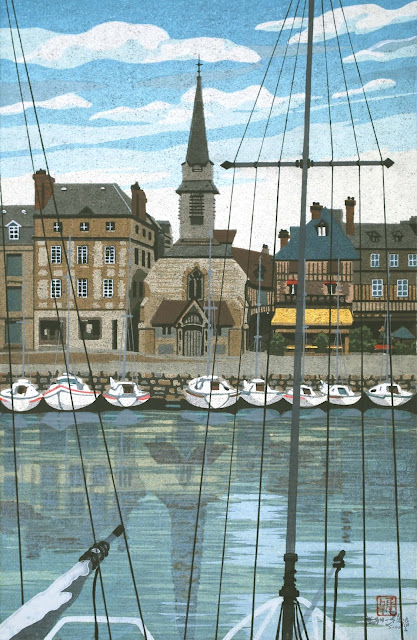井堂雅夫が木版画の制作を始めて20年ほど経った頃、コレクターの依頼でフランスのノルマンディー地方を取材する事になり、パリからジベルニー、ルーアンなどいくつかの町や村を経てオンフルールへとレンタカーでスケッチ旅行に出ました。
描きたい場所があると車を停めてスケッチ、そしてまた先へとドライブを繰り返し、日が傾き始めたらその日の取材を終え、通りがかりの村の小さな宿に泊まります。宿と言っても一階は銭湯の番台のような所に店番をする宿の主人がいて、スナック菓子やタバコ、ちょっとした日用品、ロトのような籤(くじ)などを売り、酒の立ち飲みも出来る所がフロントを兼ね、主人は近所の客の相手をしながら二階と三階にあるいくつかの客室の受付もするのです。
そんな旅の終盤に訪れたオンフルールの港はそれまで訪れた村とは違い観光地でしたが、井堂雅夫は「日本では見られないこの空と雲を木版画で表現したい」と何枚もスケッチを重ねていました。
石の文化である西洋では石版(リトグラフ)がありますが、木の文化である日本では木版画の伝統技術があります。木版画は世界最古の版画の手法で、日本だけではなく世界中にその技術がありますが、日本の気候風土で育ったコウゾ・ミツマタと豊富な水、そして日本人の繊細な技術により完成する美しく丈夫な和紙の存在が、バレンで何度も摺りを重ねる多色摺りを可能にし、浮世絵に代表される文化として大きく花開いたのです。
井堂雅夫は日本のすばらしい文化である木版画を世界に知ってもらいたいとの思いで作品創りや文化活動に目の回るような多忙な日々を送りました。そんな井堂雅夫にとって、国内にいてはなかなか持ち得ない貴重な旅の時間であったのではと思っています。
About 20 years after Masao Ido started
making woodblock prints, he decided to collect materials from the Normandy
region in France at the request of a collector, and went on a sketch trip with
a rental car from Paris to Honfleur via Giverny, Rouen and other towns and
villages.
He parks his car whenever he finds a place
he wants to draw, does the sketch and continues driving. When the sun starts to
set, he finishes the sketching day to stay at a small inn in one of the villages
he went across.
Although it could be called an inn, there
is an owner who, from a place reminiscent of an attendant`s booth of Japanese
public baths, tends a store on the first floor where snacks, cigarettes,
amenities, lottery, etc. are sold.
This venue also serves both as the front desk
for some guest rooms on the second and third floors and as a stand bar for the
locals.
The port of Honfleur, the final destination
of his trip, was a tourist spot in contrast to the villages he visited before, and
Masao Ido sketched many pieces:
"I want to express this sky and clouds
that cannot be seen in Japan with woodblock prints."
Whereas in the West, a culture of stone,
there are lithographs, in the culture of wood of Japan, the traditional
technique of woodblock printing. Woodblock printing is the oldest printing
method in the world, and its technology is available everywhere, not only in
Japan. But the beautiful and durable Japanese washi paper, arose thanks to Kozo
(paper mulberry), Mitsumata (paper birch) grown in the richly moist Japanese climate,
as well as the exquisite craftsmanship of the Japanese people, allowed several
colors to be rubbed in with the pad por pressing paper, and this led to the
flourishing of the engraving culture, vividly represented in the Ukiyo-e.
Masao Ido spent hectic days creating fine
artwork and being involved in cultural activities, dreaming of letting the
world know about a part of the beautiful Japanese culture that are woodprints. I
think that for Masao Ido, this was precious travel time that he couldn't have had
in Japan.
ギャラリー雅堂
〒603-8365
京都市北区平野宮敷町27
TEL:075-464-1655
FAX:075-464-0747
E-MAIL:mokuhanga@gado.jp
WEB: http://www.gado.jp/


0 件のコメント:
コメントを投稿